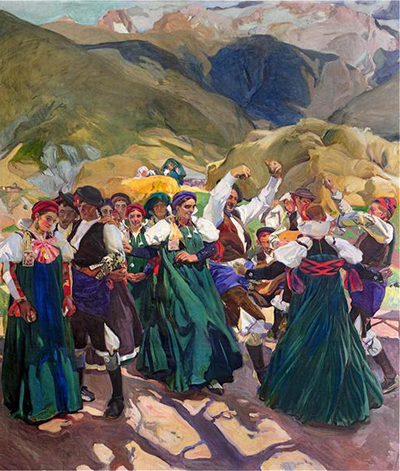 Buy Art Prints Now
Buy Art Prints Nowfrom Amazon
* As an Amazon Associate, and partner with Google Adsense and Ezoic, I earn from qualifying purchases.
This painting featured in Joaquin Sorolla's Vision of Spain, which was a series of 14 huge canvases that he completed between the years 1913–19. They collectively reflected the different regions of his native Spain and remain today on show at the Hispanic Society of America in New York City, USA.
The artist was tasked with capturing the lives of the Spanish peoples with this exciting series of compositions which took in different parts of this varied and highly cultured region. Sorolla would travel to these different locations in order to better understand each one prior to making each of these paintings, as he had not previously been to some of the places that would be included. He was a proud Valencian who would often tell others abroad about the beauty of his region when travelling to the US or elsewhere in Europe in order to promote his work through a series of exhibtions. It is likely that this is how he actually acquired the commission in the first place to produce this bold and ambitious series of paintings that was designed to help those with Spanish roots living in the US to be able to re-connect with their past, whichever part of the country their families had emerged from.
Aragon is a region in the North East of Spain from where it is believed Jota originally emerged. Jota is a combination of music and dance which is being celebrated within this painting. Typically those involved would wear traditional costumes and Sorolla himself may even have become aware of this form of music and dance whilst growing up in Valencia where it had also spread by the time he was born. Aragon itself is known for dramatic and varied backdrops, producing huge mountains and valleys and Sorolla here chooses to add that into the background in order to perfectly capture this famous part of the country. The bright tones used by this artist in the 20th century are ideally suited to the beautiful traditional costumes worn by this people, with greens, blues, reds and purples being delivered in solid forms across long dresses and headwear. A tree provides shade in the foreground, before light saturates the backdrop, with clouds floating above in the far distance.
Sorolla gained success in the US earlier than he did in some other European nations and so would travel there to host several exhibitions as he sought to achieve a more prosperous career in his latter years. He eventually managed this and he considered the US and Spain to be the best places for him to sell his work for a number of years. This ultimately led to the commission for this series of paintings which has helped him to retain his reputation in the US up to the present day, as the items are all still on display in their intended original location. He would also have been incredibly proud to have been given this opportunity, and one can also draw comparisons with the Slav Epic of Alphonse Mucha, though that series was based on historical events rather than cultural facets of the different provincial regions.



